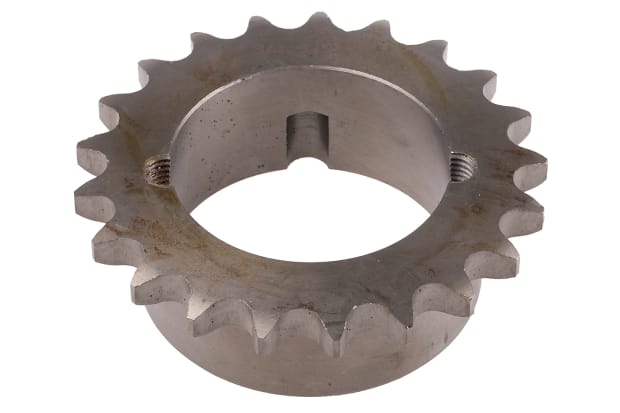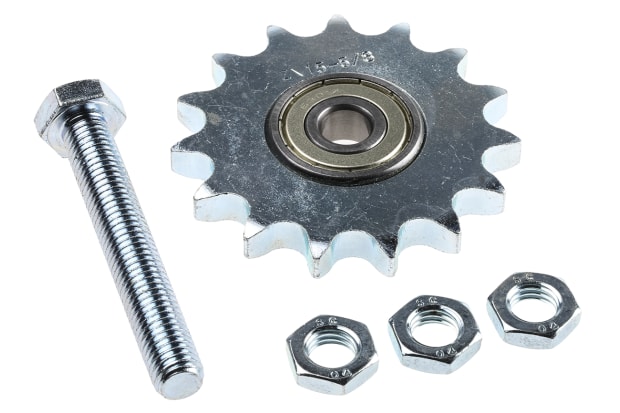- Published 30 Jan 2023
- Last Modified 29 Aug 2023
- 6 min
A Complete Guide to Sprockets
Find out what sprockets are, the types available and how to choose the right one for a chain.

What is a sprocket?
A sprocket is a simple mechanical wheel with teeth or small notches which are designed to rotate and engage with the links of a chain or belt. To be compatible, though, they both need to have the same thickness and pitch.
The basic design of this device has been used all over the world for a long time. They look very similar to gears, however they aren’t designed to be meshed together. Sprockets are used for various different applications including bicycles, cars, motorcycles, tools and other machinery.
They’re often made from steel, which is hardwearing so it increases longevity. Sometimes they’re made from aluminium as it’s lighter, making it ideal for motorbikes or push bikes, however it does wear quicker than steel.
Parts of a Sprocket
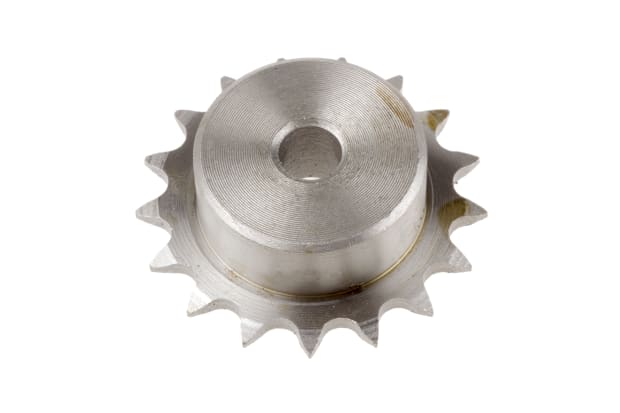
Each sprocket has a number of differing characteristics, which includes the following:
Number of teeth: This is the total amount of teeth found on the sprocket, individually called a tooth.
Pitch Diameter: This is the circumference of the sprocket at the inner point between the teeth point where the chain meets the sprocket.
Outside Diameter: The circumference around the sprocket at the end tips of the teeth.
Pitch: The full measurement per tooth, usually represented in inches. This needs to fit the pitch between the pins on a chain.
The different types of sprockets
There’s a range of different sprockets, which are available in many shapes and sizes and with varying numbers of notches. Here’s a list of some of the standard types and what they’re commonly used for:
- Double duty - These have two teeth per pitch – so that when one set is worn down the links can be advanced to a new set of teeth.
- Hunting tooth - These have an uneven number of teeth, meaning they tend to last longer than other types because every time it turns, the links engage a new set of teeth. This means each tooth makes contact only half as many times as other types of sprocket, helping it last longer.
- Segmental rim - These have bolt-on rims in either three, four or more pieces. The rim can be replaced without removing the chain from the sprocket or the sprocket from the shaft. This makes them useful for elevators or other industrial settings because they help reduce costly shutdown during installation and adjustment.
- Multiple strand - This type is used where more torque and power is needed or if two or more items are being powered by the same drive shaft.
- Quick disconnect (QD) - These tend to be used with higher working loads, and some feature a reverse mounting function.
- Idler - These are used where long lengths of chain can slack, to help avoid whipping, or where it’s been guided around an obstruction. It also helps prevent uneven load distribution.
Fitting to a shaft
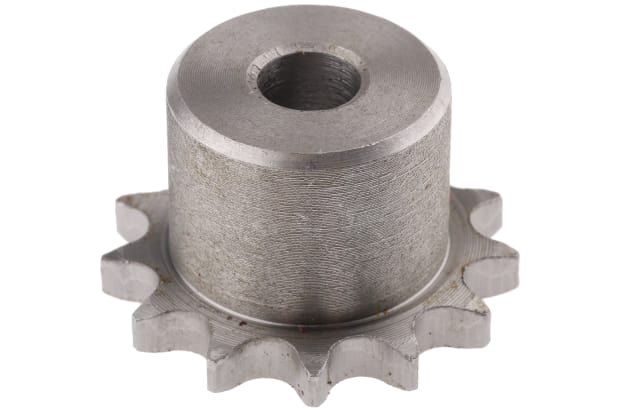
Pilot bore sprockets These types of sprockets are often used in industrial machinery, as well as bikes and motorcycles.Pilot bore sprockets feature a cylindrical projection that can be drilled to the bore size required to provide a contact surface around the shaft. They can then be fixed with a grub screw, pin, locking bushes etc. There will be a limit to the drill size based on the outer diameter of the hub, the manufacturer will specify the limits.
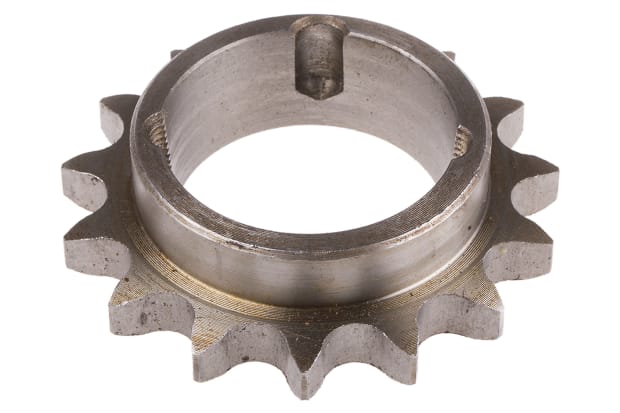
Taper bush sprockets These types of sprockets have a split through the taper and flange to provide a clamp on the shaft. They use British Standard taper bushes to get down to the size you require to fit a shaft.
How do sprockets work?
A chain or belt is used to connect two sprockets, with one being the ‘driver’ and the other being ‘driven’. Motion or force then drives them, which transmits power or changes the torque or speed of a mechanical system.
Sprockets with more teeth are able to move heavier amounts of weight, however they produce more friction, which reduces operating speed.
As a chain passes over, it wears away the notches, so if they’ve become sharpened or hooked at the tip instead of being blunt they need to be replaced.
Common uses of sprockets
They’re regularly used on bicycles to pull a linked chain to turn the movement of the rider's feet into rotation of the bike’s wheels.
Sprockets are also used on tracked vehicles such as tanks and farming machinery. They line up with the links of a track and pull them as it rotates, allowing the vehicle to move. This distributes the weight of the vehicle across the entire track, which is what enables tracked vehicles to travel across uneven ground more carefully.
In film cameras and film projectors, sprockets are used to hold the film in place and move it as photographs are taken. They're also used to thread movies on film.
Selecting a sprocket for a chain
Sprockets are available with 1, 2 or 3 rows of teeth to suit they chain they are working with - know as simplex, duplex or triplex sprockets.Simplex is the most common type, covering around 70% of market applications, Duplex being around 25% and Triplex at 5%.
Standards and chain sizes
The two chain standards that are most commonly seen on the market are:
- British Standard (BS) - also known as European Standard
- American Standard (ANSI)
For both of these standards, there are a range of different chain sizes that you may come across:

The sizes will often finish with a hyphen, followed by a number between 1 and 3. This describes the number of strands that are needed for that particular chain (1 meaning a simplex is needed, 2 meaning a duplex and 3 meaning a triplex). For example, '12B-2' means the chain will require a duplex sprocket.
Please note: these are imperial products i.e. inches. But dimension are converted to metric to give the impression that they are Metric products to suite Europe, which is a Metric market. The same is true for chains and hydraulics.
You will then need to decide the size, OD or number of teeth to determine the force ratio.
Calculating the sprocket ratio
This is the number of teeth on the driving sprocket divided by the number of teeth on the driven sprocket. For example, a front sprocket on has 20 teeth and the rear sprocket has 60, the sprocket ratio is 20/60 = 1/3 = 1:3 or 3.
What’s the difference between a gear and a sprocket?
They’re both used to transmit power in machines or move other items by interlocking with them, but the main difference between a sprocket and a gear is how they work on a practical level. Both tend to be wheels with notches for use in machinery, meaning they look very similar, but the way they operate and what they do is different.
Usually gears are designed to link together to transmit movement to them, which then causes movement elsewhere. So sprockets normally work directly with some part of the machinery, and gears often push against each other and use their collective movement to cause larger mechanical movement.
This means sprockets are designed to directly move something such as a chain or belt, so they work more independently, whereas gears create a network to increase strength and cause movement.
The differences can also be seen when inspecting the grooves of both devices. As gears mesh directly together, the notches could be on the outside of the wheel as well as the inside circumference.
Whereas sprockets have teeth which are built to fit precisely into slots of the device it’s designed to move. This means that they’re restricted in the types of applications they can be used for.

This is a sprocket

This is a gear
Top brands
There’s a wide variety of different products to choose from – ideal for a range of applications. To see more, click through for the full product range.
